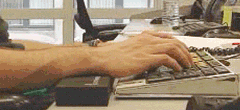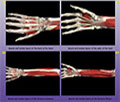Paul Manley Back Pain and RSI Clinic
Paul Manley, M.A.O.(Manip), Registered OsteomyologistFor muscle and joint problems

RSM (Royal Society of Medicine)
Specialist in the treatment of Musculo-skeletal problems
Location: 8-10 Boston Place, Marylebone, London NW1 6QH
Next to Marylebone Station, Main line trains and Bakerloo line
19/01/2026
RSI pathophysiology
What is RSI?>> RSI muscle triggers>> RSI nerve triggers>> RSI pathophysiology>> RSI treatment
I
too have suffered many repetitive strain injuries as a result of the hands-on
work that I do in clinic. Intense guitar playing and ‘mousing’ my
PC for hours creating websites such as this one don’t help either. However,
such episodes have served to edify me with regard to the general
and specific nature of finger, wrist, arm, shoulder, neck and upper
ribcage interactions. Said interactions manifest via lines of tension,
nerve pain, pins and needles, muscle ache and joint ache by virtue
of a sequence of shortening of adjacent structures in response
to habit and irritation.

I have found that the majority of symptoms arise from the deep muscles, however, often the tendons of the superficial muscles are irritated as they pass over areas where the carpal bones, for example, are misaligned and or inflammed.
When the deep ‘stabilising’ muscles of the forearm become hypertonic or overly tense they lose Oxygen and rapidly tire, causing pain. This reaction in the deep muscles is more likely than with the superficial layers due to the type of reflex tone setting mechanism and because of restriction to their expansion. The girth of the deep muscles is more tightly constrained than the superficial muscles. This physical constraint to expansion is due to the membranous sheath which envelopes every skeletal muscle of the body. Described as a 'stout' membrane, the epimysium is a layer of connective tissue which ensheaths the entire muscle. It is composed of dense connective tissue and is continuous with the fascia of adjacent muscles and the internal connective tissue wrappings within the muscles.
The density of this sheath varies from deep to superficial muscle layers. Thus, when the deep muscles expand through constant and also unique occasions of overuse they become constrained by the limits of the dense membranes enveloping them. When this state of hypertonus has persisted for some time the nervous system registers the increased tone as normal and automatically maintains the tension even though it is no longer appropriate. Pain will be generally perceived at the anchor points of the muscles and their tendons i.e. the elbow and upper forearm, and the fingers and wrist.
Often I have observed that the superficial layer is weak and flaccid whilst the deep layers are very dense and shortened. Observation of top professional pianists demonstrates that the relaxed, flowing approach to playing, honed by many years of skill acquisition and the relative absence of poor postural and technique habits plus familiarity with their own repertoire serves to maximise their performance abilities. However, even these performers can be struck down by injuries such as falls on to the hand, gardening, decorating, writing, carrying heavy bags, and a host of other trauma.
The Carpal bones form a cute little paired arch which sit, tightly bound together. They can suffer from what might best be described as 'disruption'. Some of the Carpal bones can slip slightly out of line with its' neighbours. Adhesions which make the Carpal bones glue together are common, usually as the result of a fall or twist strain. The Carpals which are stuck will no longer function in their required movement ranges. These 'disruptions' are frequently painful. The type of pain can be sudden, the type that makes you whince and then it is suddenly much less when you move your hand to instinctively relieve it. These can be inflammed in very specific areas and very persistent unless corrected by accurate joint articulation and manipulation.

What is RSI?>> RSI muscle triggers>> RSI nerve triggers>> RSI pathophysiology>> RSI treatment
07925 616 753
Location: 8-10 Boston Place, Marylebone, London NW1 6QH
Next to Marylebone Station, Main line trains and Bakerloo line
